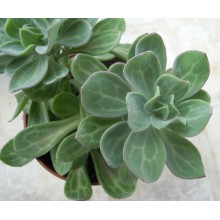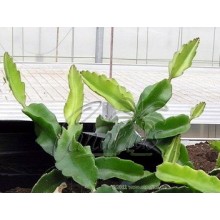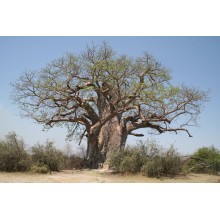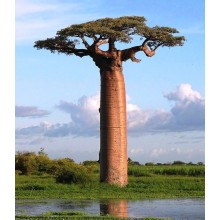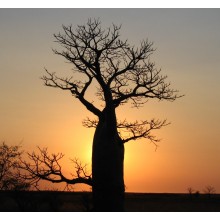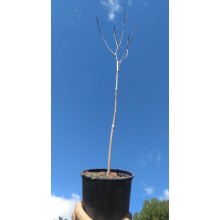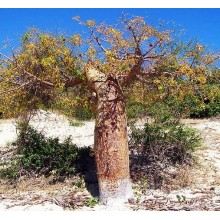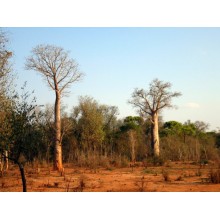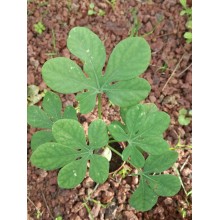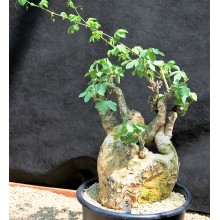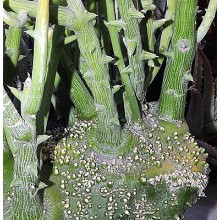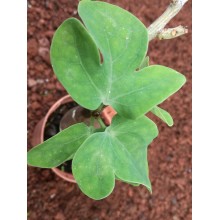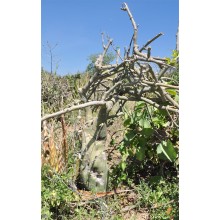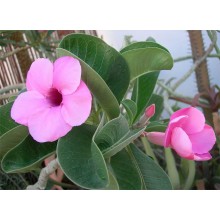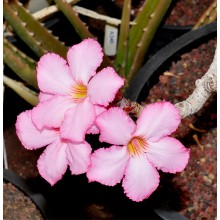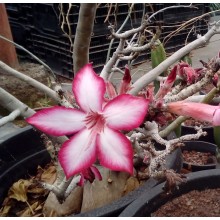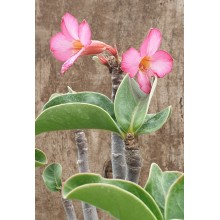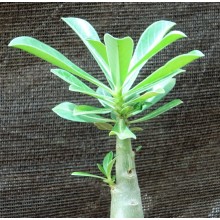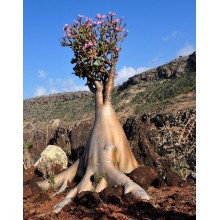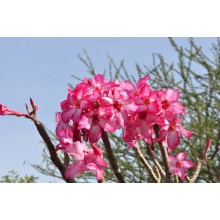Succulents There are 620 products.

World deserts and dry areas are home to the most interesting plants. Canarius offers an increasing selection of succulent plants of maximum quality, because they are grown outdoors, under the full sun of the Canary Islands.
Succulents or "fat plants" are water-retaining species, adapted to dry conditions. They store succum (juice, water) in their leaves, stems or roots, and often show a stout and fleshy appearance.
Subcategories
-
Agave
Agave is a genus of succulent plants from America. Some species grow in cold areas and take hard frost, while some others live in tropical climates. Some are tiny dwarfs and some are giants, up to 2 or 3 m wide.
Cold hardy agaves can create an exotic effect in your garden. Agave species make fine companions to palms or cacti. Variegated agaves are incredibly sought after by collectors. Our web shop offers an ever changing selection of species. We ship bare rooted plants, unless otherwise specified.
-
Aloe, Gasteria & Haworthia
Aloe, Gasteria and Haworthia are three related genera, comprising hundreds of succulent plants. They are all easily grown in pots. A few adapt to low-light levels of indoor conditions and can be grown as house plants.
- Aloe is a genus of about 400 species, native to Africa, Arabia and Madagascar. Small or dwarf aloes are becoming especially popular in colder climates as they can be taken indoors during the hardest months.
- Gasteria includes some 80 species endemic to South Africa, known for their spectacular leaves which are glossy, mottled and textured. They bloom in Spring-Summer with long spikes of small orange flowers. Some species are so variable that we offer particular clones from specific locations.
- Haworthia is a genus endemic to South Africa with about 70 species and a number of local subspecies, varieties and forms. Leaves are often banded, speckled, dotted, or semi-translucent and show wide variations.
-
Crassulaceae
This is a new, growing section of species from the family Crassulaceae. There are about 1,400 species in 33 genera and their distribution is worldwide, but mostly occur in the Northern Hemisphere and Southern Africa, especially in dry habitats. Here you can buy healthy, sun-hardened plants grown in the Canary Islands and shipped to your home.
-
Mesembs
This group of desert plants is briefly named Mesembs because they belong to a botanical family formerly named Mesembryanthemaceae. There are almost 2.000 species, mainly found in Southern Africa, with extreme adaptations to dry habitats. Some are called "living stones", as they look like pebbles. Many are easy to grow and their main need is full sun. Some are difficult because they grow in truly extreme areas.
Our Web Shop offers sun grown healthy plants, with compact and colourful leaves. Some plants are sold as cuttings, and others as rooted plants, of at least two years old.
-
Sansevieria
Recently assigned to the family Asparagaceae, the genus Sansevieria counts about 70 species, nearly all native to Africa, Arabia and Madagascar. Perennial herbs adapted to dry habitats with stiff, succulent leaves, their length ranges from a few centimeters to 2 meters. Sansevieria trifasciata and its many cultivars are among the most popular houseplants, popularly called mother in law's tongue. A well grown plant usually produces a spike of many white, richly scented flowers and then orange berries. Even the rarest species are resistant to neglect, provided you keep them from frost in winter and scorching sun in summer.
-
Hoya
Hoyas are twining vines, with showy exotic flowers, from the rainforests in Asia and Oceania. Most species grow in bright shade or morning sun, but they will also grow indoors as house plants. They are well suited for baskets, trellises or ladders. They tolerate a few weeks of drought but they are sensitive to frost and cold. Many hoyas are easy to grow and bloom, while some are tricky and rare.
-
Asclepiads
Asclepiads or Asclepiadoideae are a subfamily in the Apocynaceae, with about 2900 species. There are lots of leafless stem succulents but also perennial herbs, shrubs, lianas or rarely trees. They produce remarkable flowers, for the complex mechanisms they have developed for pollination. Many species produce an unusual fragrance, often called "carrion", and attracts flies for pollination. -
Caudiciforms
These plants from dry areas produce an unusually thick stem, the caudex. They are also called pachycauls and they have a disproportionately thick trunk, often with few branches. The caudex can be hidden underground, but in most cases they grow upwards, forming spectacular trees. The largest caudiciforms in the world are the baobabs. -
Other succulents
Here you will find all those species of desert plants that are not included in their own category. We will place here all plants from unusual families, other than Agaves, Aloes, Crassulaceae, Sansevieria, Mesembs, Epiphytic cacti, etc.
-
Senecio nyikensis
Senecio nyikensis
Low growing succulent with shrubby or scrambling stems. Leaves show an attractive pattern and the whole plant is very ornamental.
10,40 € -
Selenicereus undatus - Pitahaya Red skin White pulp
Selenicereus undatus - Pitahaya Red skin White pulp
Rooted cutting of 20-25 cm. Red pitahaya is the most popular in cultivation. Its best pollen-mate is H.purpusii. The name of the species is for its undulate or wavy margins of the ribs.
21,70 € -
Adansonia digitata Senegal
Adansonia digitata Senegal
The African Baobab is a beautiful symbolic tree, able to attain a gigantic size. It is easy to cultivate in pots, as long as it is kept above 8 C and kept dry in winter, when leafless. Leaves are dark green, glossy and palmate. Flowers are an absolute beauty. The fruit is edible.
34,00 € -
Adansonia grandidieri
Adansonia grandidieri
This is the most fabulous of all baobabs. It is a giant tree from Madagascar, forming a missile-like trunk.
48,40 € -
Adansonia gregorii
Adansonia gregorii
The Australian Baobab, or Boab, is the only species existing outside of Africa and Madagascar. It is found in Northern Australia and grows into a huge bottle tree.
43,20 € -
Adansonia madagascariensis
Adansonia madagascariensis
Baobabs are deciduous trees. They leaf out late, usually in June and drop their leaves in October to March.
123,20 € -
Adansonia rubrostipa
Adansonia rubrostipa
This Adansonia rubrostipa 'Fony' is considered the cold hardiest of all baobabs.
36,70 € -
Adansonia za
Adansonia za
Adansonia za grows in different types of dry habitats, in the West and South of Madagascar. It builds trunks up to 10 m in diameter and bears large and beautiful orange flowers with a curly petal.
113,20 € -
Adenia glauca
Adenia glauca
Beautifull caudiciform from South Africa, with a very attractive rounded grey-and-white caudex and nice lobate leaves, reminiscent of many passifloras that belong to its same family.
16,20 € -
Adenia glauca - Large
Adenia glauca - Large
Larger specimen of this species with a very attractive rounded grey-and-white caudex and nice lobate leaves, reminiscent of many passifloras that belong to its same family.
57,00 € -
Adenia globosa
Adenia globosa
Very exotic caudex, with a swollen green base. The plant lacks leaves and all the stems are green for photosynthesis. With time, well grown specimens will show a striking symmetry.
19,20 € -
Adenia spinosa
Adenia spinosa
Impressive caudiciform with short, thick and gnarled caudex. Each one is different! Above the main stem it produces scrambling or mildly climbing twigs. Found in Limpopo Province, and in Botswana and Zimbabwe.
16,20 € -
Adenium boehmianum
Adenium boehmianum
The most delicate-looking of all the wild adeniums, this "bohemian" Adenium has pink flowers with rounded petals and round tipped spathulate leaves.
30,50 € -
Adenium dhofarense
Adenium dhofarense
New species of Adenium from the Dhofar region, with especially attractive, bottle-shaped stems. The shrub is "polymorphic"and can be tall or squat depending on the conditions, or even pendant when growing on a vertical cliff.
36,20 € -
Adenium obesum Kenya
Adenium obesum Kenya
Adenium obesum is the well known rose-of-the-desert and it is widespread in Africa and very variable.
21,40 € -
Adenium socotranum
Adenium socotranum
Socotranum is one the most admired species in the genus Adenium. It attains a huge size, of two, three or more meters in height. Showy clusters of pink flowers are regularly produced in Adult plants.
42,60 € -
Adenium somalense
Adenium somalense
Adenium somalense is one of the most beautiful caudiciform plants. It grows wild in Somalia and through the Rift Valley into Ethiopia, Kenya, and Tanzania. Depending on the area, its trunk can take different shapes from a fat shrub to a small tree (more than 4 m), differently from the similar species A. obesum whose caudex is mainly underground. The showy...
41,00 €
At the moment there are few products in this category Succulents

























